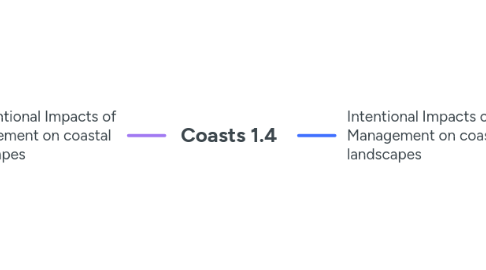
1. Unintentional Impacts of Management on coastal landscapes
1.1. Bournemouth Case Study
1.1.1. Physical Features of Bournemouth Coastline
1.1.1.1. SW Prevailing wind
1.1.1.2. North Easterly waves
1.1.1.3. 0.5-2 metre wave height
1.1.1.4. 20,000m3 sediment per year
1.1.2. Why Protect Bournemouth
1.1.2.1. 4.7 million visit each year
1.1.2.1.1. $425 million contributed to local economy
1.1.2.2. Finance industries employ 11,000 plus people and contribute £879 million to national economy
1.1.2.2.1. Biggest financial employers include JP Morgan (4000 employees)
1.1.2.3. Bournemouth University has 19,000 students and 1,500 staff
1.1.2.3.1. Contributes £1 million a day to local economy
1.1.2.4. Prime tourist location with a blue flag for water quality
1.1.2.4.1. Climate change means sea levels could risee 0.6m here
1.1.3. Management Stratgies and Impacts
1.1.3.1. Construction of Rock groynes to maintain the tourist drawn beach at Sandbanks
1.1.3.1.1. Restricts sediment from entering harbour, allowing for continual shipping access and reduces rate of erosion
1.1.3.2. Beach Nourishment to conserve the beaches
1.1.3.2.1. Sand Dredged from offshore and sprayed onto the beach in a process called 'Rainbowing'
1.1.4. Intended and unintended impacts of Coastal management
1.1.4.1. Long Groyne
1.1.4.1.1. Trapping sediment from longshore drift meaning there is very little goung into Christchurch bay
1.1.4.2. Mudfort Spit is reducing 5-10% each year
1.1.4.3. Beaches infront of Barton (otherside of long groyne) have eroded away
1.1.4.4. Climate change mean sea levels are supposed to rise 60cm in 100 years
1.1.4.4.1. Would cause £18 million worth of damage
1.2. Mangawhai-Pakiri Case Study
1.2.1. Location of the coastline
1.2.1.1. East Coast of New Zealands Northern island
1.2.1.1.1. Pakiri beach is 80km north of Aukland
1.2.2. Importance of Pakiri Sand to Economic Development
1.2.2.1. Construction
1.2.2.1.1. Firms continue to mine sand because of the quality and value of the pakiri sand needed for construction projects in Aukland
1.2.2.2. Coastal Management
1.2.2.2.1. The mined sand is also used to replenish beaches at mission bay and St Heliers
1.2.2.3. Tourism
1.2.2.3.1. The Pakiri coastline attracted 2.3 million international tourists in 2015
1.2.3. Origin of the Sand
1.2.3.1. Last ice age the sea water level was 90m lower than today edging the continental shelf made up of beaches and dunes
1.2.3.2. As the glacial period ended the sea level rose during the flandrian transgression
1.2.3.2.1. The beaches and dunes retreated inland by the action of waves prevailing wind nearly all of the 9000 year old sediment was swept towards land
1.2.4. Impact on Coastal landforms
1.2.4.1. Sand extraction is unsustainable
1.2.4.1.1. Beaches are starved of sediment and have a profile that has become less effective at absorbing wave energy
1.2.4.1.2. 1994-2004 over 165,000 m3 a year was extracted
1.2.4.2. Positive feedback loop is created
1.2.4.2.1. Mining starves dunes and beaches from sediment, leading to erosion of these beaches with sediment moving offshore and continuing to be mined
1.2.4.3. Coastal retreat is already evident and is attributed to sand extraction
1.2.4.3.1. Long term retreat by the end of the centure is estimated to be 35 metres up to 111 metres in some particularily affected areas
1.2.4.3.2. This puts major towns like Mangawhai at risk of flooding
2. Intentional Impacts on Management on coastal landscapes
2.1. Felixstowe Case Study
2.1.1. Felixstowe has defenses, Bawdsey doesn't
2.1.1.1. Bawdsey and Felixstowe have the same geology, Bawdsey has 1 metre of annual erosion, and because Felixstowe is more economically valuable it has to be managed
2.1.1.2. Bawdsey is a major source of sediment for the cell, so management would have consequences on sediment load
2.1.1.3. Bawdsey is predominantly agricultural land, while Felixstowe is a high value urban area
2.1.2. Felixstowe Stats
2.1.2.1. UK's busiest container port
2.1.2.1.1. 48% of Britains containerised trade handled
2.1.2.1.2. 32,000 individuals employed there generating £60bn of business a year for the UK
2.1.2.2. Tourism Sector
2.1.2.2.1. Includes 800 businesses, employing 12% of towns workforce
2.1.3. The Suffolk SMP (Shoreline Management Plan)
2.1.3.1. Managed by a range of players including local council, environment agency and private owners of the port of Felixstowe
2.1.3.2. 50KM of the coast designated Heritage coast
2.1.3.2.1. 6.5Km refended by the council against erosion
2.1.3.3. North of Deben river (Bawdsey) a no active intervention plan has been imposed
2.1.3.3.1. North and South of Cobbolds point there is a hold the line management plan
2.1.3.4. Environment agency agreed to fund the £55 million scheme to update coastal defenses in Felixstowe in 2011
2.1.3.4.1. 18 New rock groynes, 350m rock revetment, new fish tailed groynes, construction of 250m more sea wall and 5 rock groynes at languard point to extend the edge of the nature reserve
2.1.3.4.2. This was necessary as the groynes previosuly installed in early 20th centure were worn out
2.1.4. Influence of intentional human activity
2.1.4.1. Economic development
2.1.4.1.1. Economic confidence in the area
2.1.4.2. Altering flows of energy and geomorphic processes
2.1.4.2.1. Construction of fish tailed groynes
2.1.4.3. Modification of landforms
2.1.4.3.1. Modifying Languard spit, by adding 5 new rock groynes and 250m more sea wall in an attempt to extend northern edge of nature reserve
2.1.4.3.2. Modifying Beaches with 80,000m3 of beach nourishment across the coastline as part of 2011 update scheme
2.1.4.4. Unintended consequences of intentional human activity
2.1.4.4.1. Languard spit reduced by 15% over the last 25 years
